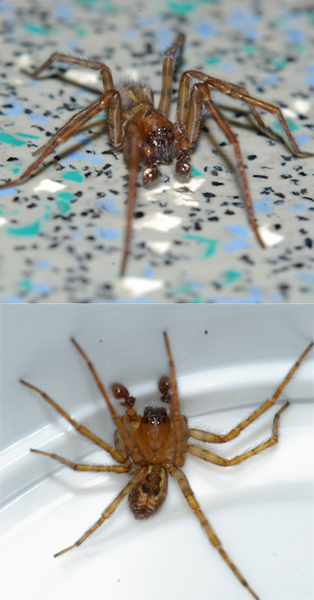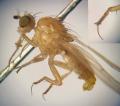Diptera.info :: Identification queries :: Other insects, spiders, etc.
|
Some kind of House Spider?<Amaurobius sp.
|
|
| Roger Thomason |
Posted on 26-11-2008 10:47
|
|
Member Location: Mossbank,Shetland Isles. Posts: 5268 Joined: 17.07.08 |
Found wandering around at Scatsta Airport. What's its name?
Roger Thomason attached the following image:  [133.93Kb] Edited by Roger Thomason on 28-11-2008 10:12 |
|
|
|
| Juergen Peters |
Posted on 26-11-2008 11:38
|
|
Member Location: northwest Germany Posts: 14332 Joined: 11.09.04 |
Hello, Roger! rogerthomason wrote: Found wandering around at Scatsta Airport. What's its name? It's a male Amaurobius (Amaurobiidae), most likely A. similis (often in houses). Best regards, Jürgen -=-=-=-=-=-=-=-=-=-=-=-=-=-=-=-= Juergen Peters Borgholzhausen, Germany WWW: http://insektenfo... -=-=-=-=-=-=-=-=-=-=-=-=-=-=-=-= |
| Smoggycb |
Posted on 26-11-2008 15:58
|
|
Member Location: Rye Harbour, England Posts: 350 Joined: 19.05.07 |
If the white on the palps is not an artifact of the flash, then this is A. ferox (see image here http://www.afblum...aufero.JPG). The other two British species don't have this.
Edited by Smoggycb on 26-11-2008 16:03 |
|
|
|
| Roger Thomason |
Posted on 26-11-2008 17:50
|
|
Member Location: Mossbank,Shetland Isles. Posts: 5268 Joined: 17.07.08 |
Thanks Juergen and Chris for your replies. Those white marks on the palps are present on this spider, and look like teeth or claws which are retracted. Can't show a close up as this system only allows 1 photo per thread . which is why I am sending split images. So this will be A.ferox then? . which is why I am sending split images. So this will be A.ferox then?Unless J.B. pipes up again  . This is not on my Checklist . This is not on my ChecklistRegards Roger |
|
|
|
| Smoggycb |
Posted on 26-11-2008 17:59
|
|
Member Location: Rye Harbour, England Posts: 350 Joined: 19.05.07 |
If those white marks are there (it's actually the palpal 'bulb', the part of the palp that contains the working parts like sperm ducts and the like), then this is A. ferox - congratulations! |
|
|
|
| Roger Thomason |
Posted on 26-11-2008 18:05
|
|
Member Location: Mossbank,Shetland Isles. Posts: 5268 Joined: 17.07.08 |
Do I win a prize ? |
|
|
|
| Juergen Peters |
Posted on 27-11-2008 01:13
|
|
Member Location: northwest Germany Posts: 14332 Joined: 11.09.04 |
Hello! Smoggycb wrote: If the white on the palps is not an artifact of the flash, then this is A. ferox (see image here http://www.afblum...aufero.JPG). The other two British species don't have this. Maybe A. ferox is much paler in Britain. Here at our house (both species are abundant) A. ferox is mostly very dark (often nearly black, the opisthosoma markings scarcely visible - and differently shaped). A. similis is mostly light brown like Roger's spider. In the key from http://www.araneae.unibe.ch/ the white on the palps is not mentioned as characteristic for one species (?). Here some (confirmed) A. ferox and similis from our house in northwest Germany (A. fenestralis mostly only occurs in the forest here and is much smaller/more fragile): A. ferox male: http://insektenfo...adid=14056 A. ferox female: http://insektenfo...adid=20589 A. similis males: http://insektenfo...adid=11374 http://insektenfo...adid=11494 And for completeness: A. fenestralis: http://insektenfo...enestralis http://insektenfo...enestralis http://insektenfo...enestralis Best regards, Jürgen -=-=-=-=-=-=-=-=-=-=-=-=-=-=-=-= Juergen Peters Borgholzhausen, Germany WWW: http://insektenfo... -=-=-=-=-=-=-=-=-=-=-=-=-=-=-=-= |
| Smoggycb |
Posted on 27-11-2008 09:05
|
|
Member Location: Rye Harbour, England Posts: 350 Joined: 19.05.07 |
All the specimens of A. ferox I have seen before have also been very dark, but certainly in Roberts 'Spiders of Britain & Northern Europe' the illustration of male A. ferox looks closer to Roger's spider than to other males I have seen, as does the spider in the link (on my first entry) above. And both Roberts and Jones 'Spiders of Northern Europe' mention the conspicuously white palpal bulb among British Amaurobius. My knowledge is limited to the British fauna, so maybe there are other white-palped species in Europe. If in doubt, catch it and get it under a micropscope if possible!
Edited by Smoggycb on 27-11-2008 09:06 |
|
|
|
| Roger Thomason |
Posted on 27-11-2008 15:07
|
|
Member Location: Mossbank,Shetland Isles. Posts: 5268 Joined: 17.07.08 |
Oh dear, seems like there's disagreement among the ranks  .I've looked at photo's of both species and it does look more like A.similis but even among those there are variations. I suppose we could come to a compromise and call it Amaurobis sp., or you guys could have a fight in a carpark of your choosing .I've looked at photo's of both species and it does look more like A.similis but even among those there are variations. I suppose we could come to a compromise and call it Amaurobis sp., or you guys could have a fight in a carpark of your choosing  . I could make a few quid on ticket sales...hmm, I do need a ring-flash for my camera.... . I could make a few quid on ticket sales...hmm, I do need a ring-flash for my camera.... |
|
|
|
| Smoggycb |
Posted on 28-11-2008 16:06
|
|
Member Location: Rye Harbour, England Posts: 350 Joined: 19.05.07 |
I think Amaurobius sp is probably the best bet considering. I would love to have a closer look at this one. p.s do we get a cut of the proceedings from any bout? |
|
|
|
| Roger Thomason |
Posted on 28-11-2008 16:36
|
|
Member Location: Mossbank,Shetland Isles. Posts: 5268 Joined: 17.07.08 |
NO-You just get cuts and bruises. |
|
|
|
| Jump to Forum: |













